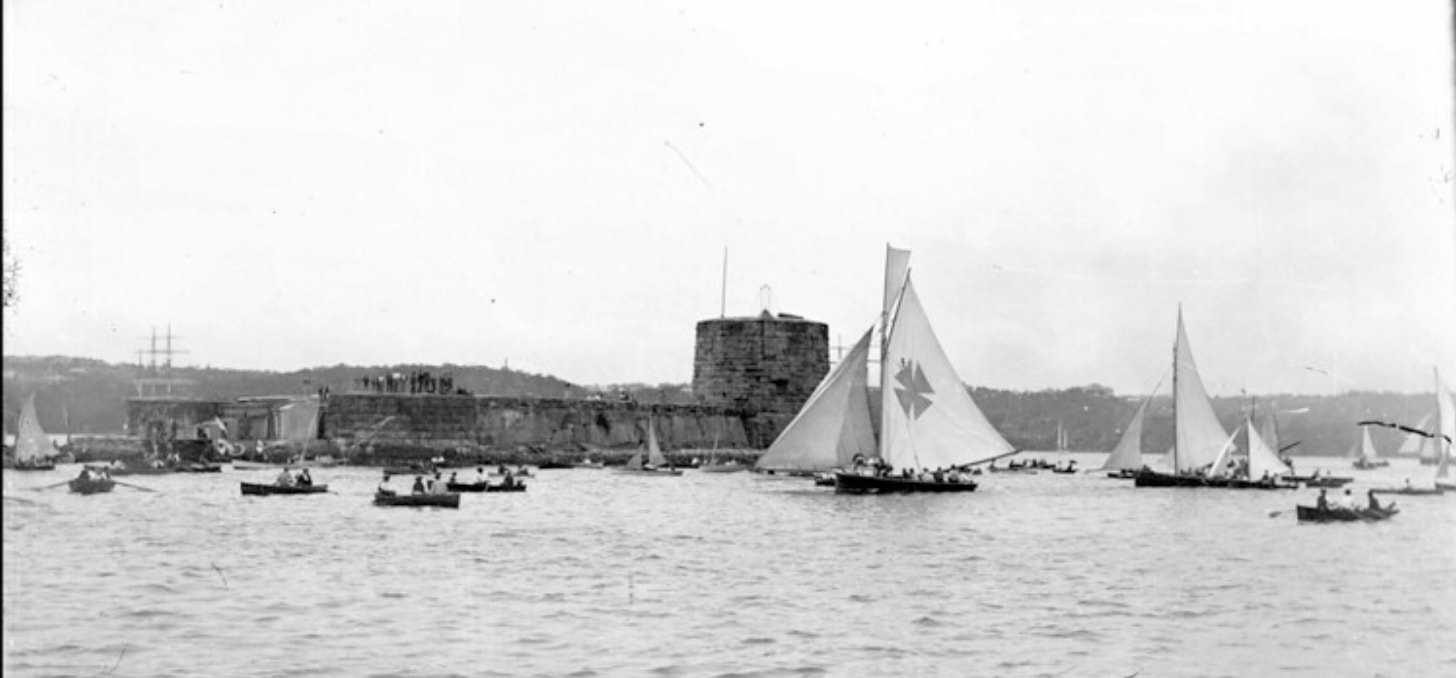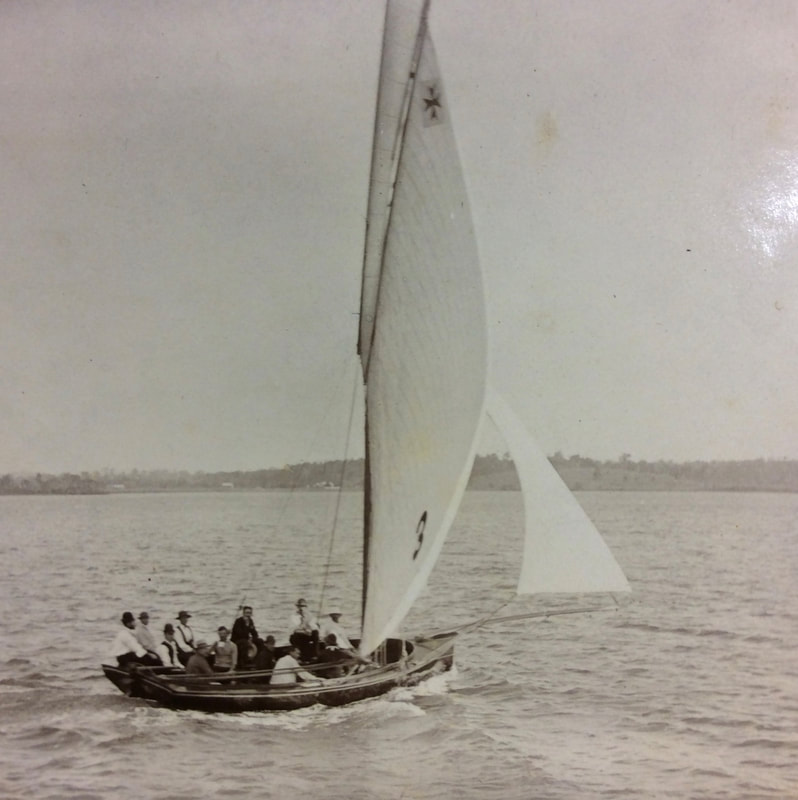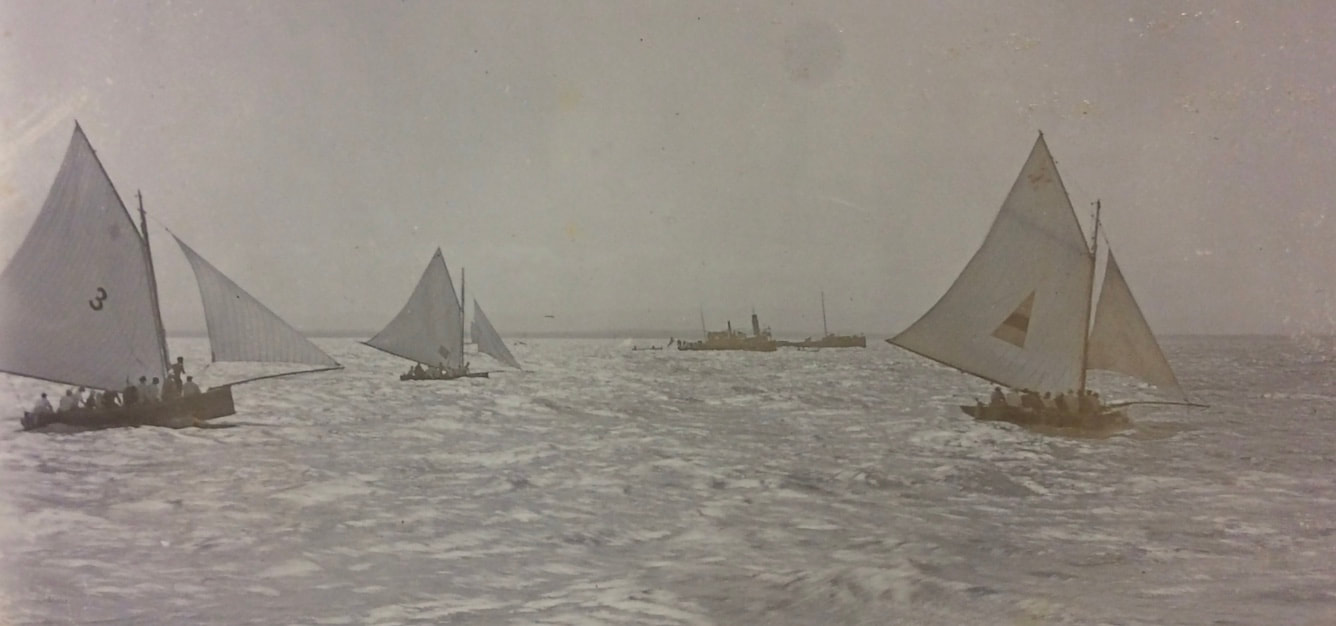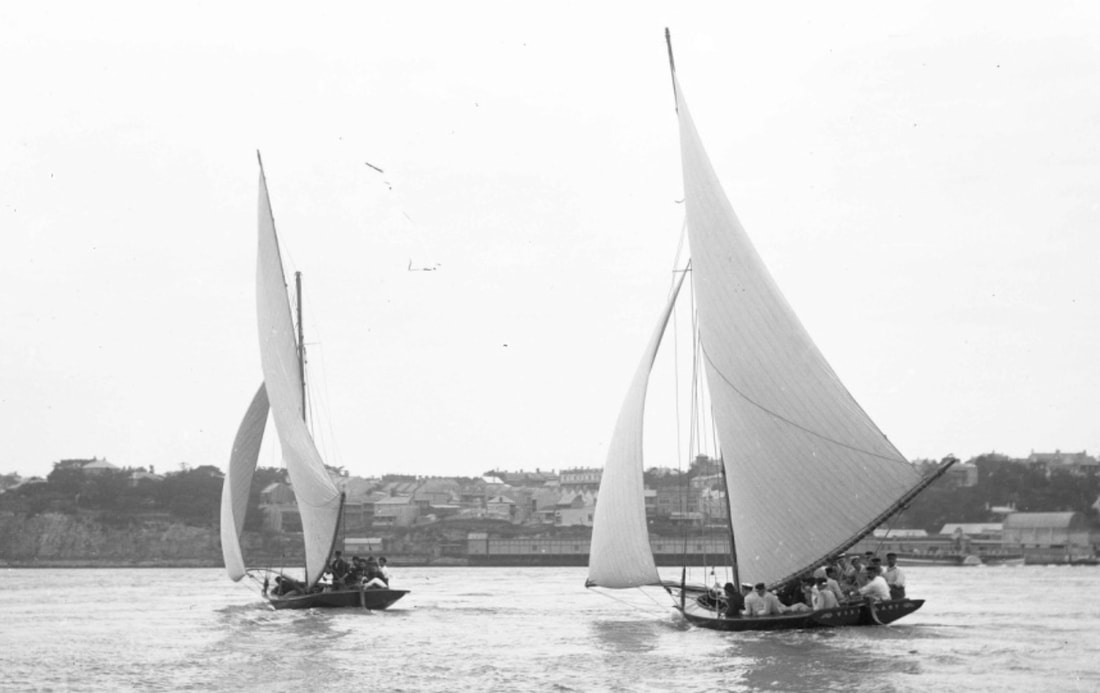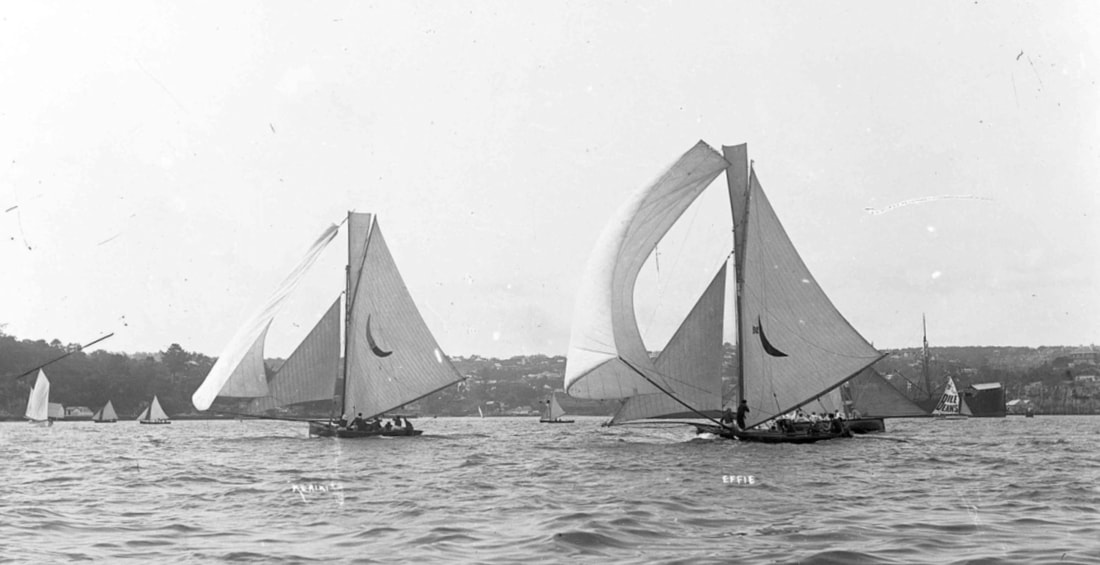The 1890's saw a series of Intercolonial Challenges between NSW and Queensland which brought the 22-footers into prominence but also sowed the ground for their replacement by the 18-footers. Public enthusiasm and media coverage was like it is for the State of Origin Rugby League today.
In the early 1890’s the dominant racing class in Sydney was the 24-footers. They attracted the most prize money and media and public attention, the most gambling and the best skippers and crews. There were also a few 22-footers, as well as 20-footers and 18-footers and the smaller classes. In Brisbane the capital of the northern colony of Queensland however there were no 24-footers, but quite a few 22-footers and 18-footers were racing (see the YARN The Story of the Brisbane 22-Footers). The local 22-footers had started out as oyster boats on Moreton Bay and began racing in the 1880’s and the newer boats built specifically to race began to follow similar design trends to those in Sydney in terms of being big beamy shallow centreboarders with large sail areas. In fact Brisbane owners imported two Golding-built boats from Sydney in the late 1880’s and early ‘90’s, Nyoola and Caneebie. Another, Clyanthus was built locally to a design by Sydney naval architect Walter Reeks. And Golding always claimed that he sold J.McCleer the moulds to build Bulletin. But there were also plenty of locally designed and built boats as well, including a large minority of clinker-built boats.
On a visit to Sydney in early 1894 Mr T Goodall the Brisbane owner of Golding’s Caneebie raised the concept of an Intercolonial challenge with Golding, and the idea took root and grew to be an invitation from the Queensland sailing clubs for Sydney to send up several 22-footers for an Intercolonial Carnival. Other colonies were invited but had no suitable boats.
The Johnson’s Bay Sailing Club selected three 22’s to go to Brisbane, Portia (G.Holmes Jun, skipper), Latona (Chris Webb) and Irex (N.Johnson). There were only two races, but neither was designated as The Championship race. The first race was held on Saturday 17 March 1894 and was won by Bulletin (JH Whereat, Qld) from Latona (NSW) and Zenobia (Qld) in a fleet of ten. A second race on Monday 19th saw Irex (NSW) win from Caneebie (Qld) and Portia (NSW). So honours were reasonably evenly divided and the rivals promised to continue the Challenge in Sydney in the 1894-5 season in Sydney.
On a visit to Sydney in early 1894 Mr T Goodall the Brisbane owner of Golding’s Caneebie raised the concept of an Intercolonial challenge with Golding, and the idea took root and grew to be an invitation from the Queensland sailing clubs for Sydney to send up several 22-footers for an Intercolonial Carnival. Other colonies were invited but had no suitable boats.
The Johnson’s Bay Sailing Club selected three 22’s to go to Brisbane, Portia (G.Holmes Jun, skipper), Latona (Chris Webb) and Irex (N.Johnson). There were only two races, but neither was designated as The Championship race. The first race was held on Saturday 17 March 1894 and was won by Bulletin (JH Whereat, Qld) from Latona (NSW) and Zenobia (Qld) in a fleet of ten. A second race on Monday 19th saw Irex (NSW) win from Caneebie (Qld) and Portia (NSW). So honours were reasonably evenly divided and the rivals promised to continue the Challenge in Sydney in the 1894-5 season in Sydney.
Esmerelda (Billy Read) winning the 1895 Intercolonial 22-footer Championship. Photo Hall Collection ANMM.
Five Queensland 22-footers made the trip down in January 1895: Bulletin (JH Whereat), plus Caneebie (T Goodall), the clinker-built Waihora (H Prentice) and two brand-new boats, Lady Norman (designed by R Hamilton, built by Wood of Kangaroo Point and skippered by FJ Clark), and Rose (built by R Wain and skippered by GH Clarke). They were to face no less than fourteen Sydney boats, none of which appear to be new, and many of which were at least 6 or 7 years old. The Championship was to be decided as usual at that time in one race, and that race was held on Saturday 19 January the course being from Pinchgut to the Lightship off the Sow and Pigs, across to the Watson’s Bay Pile Light, then around Shark Is and back to Pinchgut, twice around. Esmeralda (Billy Read) led by Shark Island the first time and was never headed. Irex (N Johnson) was second, Varuna (WM Paul) third. The nearest Queenslander was the new Lady Norman at seventh.
The fleet next raced in a special race in the Anniversary Regatta on 26 January. In a squally and rainy race from Blues Point to Manly and back via Shark, NSW boats Gladys and Rosetta capsized at Manly, Irex led to Quarantine but Bulletin got past her and won from her with Latona third. Another race the following Saturday was held by the Sydney Flying Squadron as a handicap with two heats and a final in a SE gale in which the Queensland boat Lady Norman won the second heat and the final ( steered by NSW’s Chris Webb) from Secret (Goddard, NSW) with the third boat being Vera, a Queensland 18-footer steered by NSW’s W Holmes. For this second Intercolonial Challenge the Queenslanders had also sent down three 18-footers, Vera, Victoria and Truant. Their first race was a sweepstake race on Wednesday 23 January won by Ariel (NSW, George Ellis) from Ruby and Neried (both NSW) with Victoria (Qld) fourth.
The 18’s also raced on Anniversary Day, at a time separate enough from the 22-footers’ race to enable skippers and crews to sail on both events. Ariel won this race also, from Victoria (E Clark, Qld) and Nereid (NSW).
The fleet next raced in a special race in the Anniversary Regatta on 26 January. In a squally and rainy race from Blues Point to Manly and back via Shark, NSW boats Gladys and Rosetta capsized at Manly, Irex led to Quarantine but Bulletin got past her and won from her with Latona third. Another race the following Saturday was held by the Sydney Flying Squadron as a handicap with two heats and a final in a SE gale in which the Queensland boat Lady Norman won the second heat and the final ( steered by NSW’s Chris Webb) from Secret (Goddard, NSW) with the third boat being Vera, a Queensland 18-footer steered by NSW’s W Holmes. For this second Intercolonial Challenge the Queenslanders had also sent down three 18-footers, Vera, Victoria and Truant. Their first race was a sweepstake race on Wednesday 23 January won by Ariel (NSW, George Ellis) from Ruby and Neried (both NSW) with Victoria (Qld) fourth.
The 18’s also raced on Anniversary Day, at a time separate enough from the 22-footers’ race to enable skippers and crews to sail on both events. Ariel won this race also, from Victoria (E Clark, Qld) and Nereid (NSW).
Caneebie (T Goodall, Qld) winner of the 1896 Championship on Moreton Bay. Photo Golding scrapbook, ANMM.
From left Caneebie (Qld), Ettie (Qld) and Esmerelda (NSW) before the start of the 1896 Championship race on Moreton Bay. Photo Golding scrapbook ANMM.
The 22-footers were still the main show, and for the return trip to Brisbane in the 1895-96 season the reigning Champion Esmeralda and Irex were selected to represent NSW. Three 18-footers were selected, Ariel and two Golding boats, his older Olinda and his brand-new Yvonne.
On Boxing Day 1895 the fleets met at the Cleveland Regatta on Moreton Bay. Queensland boats filled the first two placing in the 22-footers race with Ettie winning from Bulletin, with Irex and Esmeralda third and fourth. H Anderson’s local 18-footer Britannia beat NSW’s Ariel and Yvonne. Two days later the 22-Footers Championship race was held on the Bay and Queensland’s Caneebie beat Esmerelda and Irex. A third race at the Sandgate Regatta where Bulletin beat Irex and Caneebie, and a fourth race 3 days later where Ettie beat Esmerelda and Irex showed just how dominant this Queenslanders were this season. The 18-footers did little better, with Queensland’s Britannia winning the three races she entered, and the three Sydney boats only featuring in a sweepstakes race with only one Queensland entrant, Vera who capsized.
On Boxing Day 1895 the fleets met at the Cleveland Regatta on Moreton Bay. Queensland boats filled the first two placing in the 22-footers race with Ettie winning from Bulletin, with Irex and Esmeralda third and fourth. H Anderson’s local 18-footer Britannia beat NSW’s Ariel and Yvonne. Two days later the 22-Footers Championship race was held on the Bay and Queensland’s Caneebie beat Esmerelda and Irex. A third race at the Sandgate Regatta where Bulletin beat Irex and Caneebie, and a fourth race 3 days later where Ettie beat Esmerelda and Irex showed just how dominant this Queenslanders were this season. The 18-footers did little better, with Queensland’s Britannia winning the three races she entered, and the three Sydney boats only featuring in a sweepstakes race with only one Queensland entrant, Vera who capsized.
Figtree (left) and Vigilant, two of the six new 22-footers built for the 1896-97 season and the Intercolonial races. Photo Hall Collection ANMM.
The comprehensive defeat stimulated Sydney boat owners to build new boats for the 1896-7 season. Wonga (by Dearing) appeared first, followed by Figtree (Stephens), Effie (Donnelly) and Vigilant (Golding). Queenslanders built Hibiscus and Stanley. Hibiscus made the cut but Stanley didn’t, with the older Ettie, Bulletin and Caneebie making a team of four Queensland 22’s to travel South, along with proven 18’s Britannia and Vera.

A collage of shots from the 1896-97 series in Sydney from The Town and Country Journal Saturday 30 January 1897, found in TROVE, NLA. Top left is Mark Foy's catamaran Flying Fish which won one of the minor races of the series. Top right is the yacht of the Commodore of the Royal Prince Alfred Yacht Club (which had nothing to do with this series). Mid-left is the Sydney 18-footer Inez which came to Sydney as a Queensland representative named Victoria in 1895 but was sold here. Of the others, only the bottom left picture is identified as Qld 22-footer Bulletin who had won the original Championship in 1894. The capsized boat could be the new Sydney 22-footer Wonga who succumbed in the squally Championship race which also damaged several other boats in the fleet.
There was huge public interest in the event in Sydney. The JBSC and the SFS chartered two steamers each to cater for spectators. The 22’ Championship Race was held on Saturday 23 January 1897, and it was a wipeout for Queensland. Won by the old Irex steered by Fred Doran from Figtree (Chris Webb) and Vigilant (Billy Read), Caneebie and Bulletin could only manage 9th and 10th. Queensland saved a little pride when Bulletin won the 22’ race at the Anniversary Regatta in a squally breeze that saw Effie and Caneebie dismasted, Figtree lose her bumpkin and Wonga capsize. The Brisbane 22’s were also out of it on the last race on Saturday 30 January won by Mark Foy’s catamaran Flying Fish (see another YARN). And Sydney boats won all three 18-footer races, Rosamond (Chris Webb) winning the Championship and the new Thalia winning the other two. Brisbane’s best result was a second for Britannia (A Earle) in the Championship race.
Stella II by Billy Golding was the Intercolonial Champion 18-footer in both the 1898 and 1899 series. The 18's were beginning to threaten the dominance of the 22's. Photo TROVE, NLA
For the 1898 Challenge in Brisbane, the Queenslanders selected the old champions Bulletin and Caneebie along with a new boat Victoria. NSW sent the SFS Champion Vigilant (Billy Read), the JBSC Champion Effie (Nick Johnson) and the old Irex under George Ellis. In the 18-footers, the new Sydney boats Australian (Chris Webb) and Stella II (George Ellis) joined Thalia (Billy Read).
Effie won three of the four races and was second in the other (to Irex). Queensland’s best was three second placings to Caneebie. The 18-footers’ races were a little more mixed, one race each to Australian, Stella II and Britannia. The Championship race was decided on Moreton Bay on Boxing Day 1897 and Stella II won from Australian in very rough conditions, aided by her use of relatively new lee-cloths, described at the time as ‘window blinds’.
For this 1897-8 season Challenge, Sydney had also sent up a couple of 10-footers and sailing canoes, and in the next series the Queenslanders sent down a total of 13 boats, four 22-footers, and three each of 18’s, 14’s and 10-footers. Two brand new Sydney 22-footers waited to meet them, Keriki and Plover.
Effie won three of the four races and was second in the other (to Irex). Queensland’s best was three second placings to Caneebie. The 18-footers’ races were a little more mixed, one race each to Australian, Stella II and Britannia. The Championship race was decided on Moreton Bay on Boxing Day 1897 and Stella II won from Australian in very rough conditions, aided by her use of relatively new lee-cloths, described at the time as ‘window blinds’.
For this 1897-8 season Challenge, Sydney had also sent up a couple of 10-footers and sailing canoes, and in the next series the Queenslanders sent down a total of 13 boats, four 22-footers, and three each of 18’s, 14’s and 10-footers. Two brand new Sydney 22-footers waited to meet them, Keriki and Plover.
Keriki (left) and Effie the two fastest 22's ever seen ensured Sydney's dominance but perhaps hastened the end of the series. Photo Hall Collection ANMM.
This 1899 Challenge series in Sydney was a wipeout for Queensland. Effie won the 22-footer Championship and the Anniversary Day Regatta. The best the Queensland 22’s could manage was a fourth in the Championship for Stanley and a fifth for the old Caneebie. Sydney’s new Keriki and Plover had slipped into second and third. In the 18-footers Stella II won 3 out of 4 starts. It broke the Queenslanders’ hearts. There was no enthusiasm whatsoever from Brisbane for a seventh Challenge. The City of Brisbane Sailing Club announced “The apathy shown by the owners of the 18 and 22-footers in connection with the matter would not justify the committee in taking any other action than abandoning the series”.
The beginning of the series had led to the rapid displacement of the previously dominant 24-footers by the 22-footers, but the reign of the 22’s was just one brief shining moment. After the series collapsed, the Sydney 22’s only remained dominant for several more seasons. By 1902 the 18-footers were receiving more prize money and attention, and almost immediately the 22-footers began to drop out of first-class racing. Lan Taylor’s Keriki was the only 22 still racing with the SFS by 1913 and none were seen after that.
Intercolonial, or Interstate racing as it now was after Federation in 1901 was slow to resume. Brisbane half-heartedly sent a second-rate 18-footer Aeolus down in the 1903-4 season and it failed miserably. The West Australians stepped into the breech and several annual challenges for the Perth Flying Squadron Challenge Cup and the Mark Foy Challenge Cup were held in Perth and Sydney from 1906 to the mid-1920’s. Queensland only began to get involved again from 1911, and it was 1921 before they had a win with Colin Clark’s Vision.
But the main thing that emerged from the 1890’s Intercolonial Challenges was that the eighteen-footers were going to be the most popular class of open boat on Sydney Harbour.
The beginning of the series had led to the rapid displacement of the previously dominant 24-footers by the 22-footers, but the reign of the 22’s was just one brief shining moment. After the series collapsed, the Sydney 22’s only remained dominant for several more seasons. By 1902 the 18-footers were receiving more prize money and attention, and almost immediately the 22-footers began to drop out of first-class racing. Lan Taylor’s Keriki was the only 22 still racing with the SFS by 1913 and none were seen after that.
Intercolonial, or Interstate racing as it now was after Federation in 1901 was slow to resume. Brisbane half-heartedly sent a second-rate 18-footer Aeolus down in the 1903-4 season and it failed miserably. The West Australians stepped into the breech and several annual challenges for the Perth Flying Squadron Challenge Cup and the Mark Foy Challenge Cup were held in Perth and Sydney from 1906 to the mid-1920’s. Queensland only began to get involved again from 1911, and it was 1921 before they had a win with Colin Clark’s Vision.
But the main thing that emerged from the 1890’s Intercolonial Challenges was that the eighteen-footers were going to be the most popular class of open boat on Sydney Harbour.
